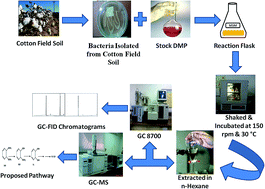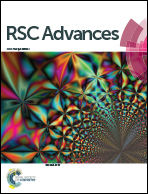Complete degradation of dimethyl phthalate by biochemical cooperation of the Bacillus thuringiensis strain isolated from cotton field soil†
Abstract
Dimethyl phthalate (DMP), a phthalate ester, is widely used in cosmetics, perfumes, and plasticizers. It has been classified as a suspected endocrine disruptor by many countries. The present study describes the biodegradation of DMP by a new aerobic bacterium, isolated from soil samples of a cotton field by an enrichment culture technique utilizing DMP as the sole source of carbon and energy. The isolate was identified as Bacillus thuringiensis based on the morphological and biochemical characteristics as well as gene sequence analysis. Bacillus thuringiensis grows best in a mineral salt medium of pH 7.0 at 30 °C incubation for 48 hours. The effects of temperature, inoculum size, substrate concentration and incubation time on DMP degradation were also studied. Bacillus thuringiensis is able to biodegrade 400 mg L−1 of DMP under aerobic conditions with 99% degradation potential. A combination of GC and GC-MS analysis revealed a complete DMP biodegradation pathway. The results indicate that Bacillus thuringiensis may prove a promising source for DMP bioremediation at a commercial scale.


 Please wait while we load your content...
Please wait while we load your content...